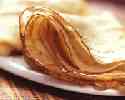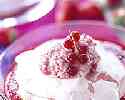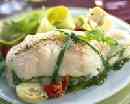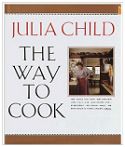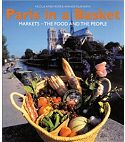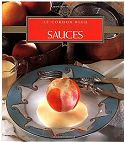|
Cooking
Techniques Relates theTypes of Cooking
Methods
In this section you'll find basic cooking
techniques for meats, vegetables, desserts overall. The French
phrase for the cooking method is
noted, as well as comparable methods. Example: Baking and
Roasting are similar procedures.
Of the above approaches to cooking food, Baking
and Roasting [a] are basically identical, as are Broiling and
Grilling [b]. The first pair really refers to cooking through the
use of dry heat; the second group entails cooking oiled food on a
preheated grill or in a preheated broiler. Essentially, there are
only six differential, but analogous ways to cook food:
Baking or Roasting;
Braising;
Broiling-Grilling;
French-frying;
Poaching and
Sautéing.
Baking-Roasting:
As stated above, dry heat is used in preparing
the food. To make sure the heat is dry, the oven is preheated to
about 450°, and the heat is gradually reduced as the food warms to a
low of about 325°. When the quantities are small, the food can be
placed in a continuously 425° oven for a shorter time. The idea
behind adjusting temperature and baking time is to insure browning
without drying out the food.
Roasts should never be covered; they should be
basted from time-to-time with butter or oil and, when done, should
be placed on a hot platter until their cooking stops.
You can test the doneness of meat by inserting
a skewer into the thickest part of the meat, leaving it there for
1.5 to 2 minutes before removing it and putting it on a white
plate. If the juice that drips from the skewer is red, the meat is
rare; if it is pink, the meat is medium. When the juice is clear,
or white colored, the meat is well done.
Braising:
For the best results in braising food, you
should cook it in a liquid that has been enriched with stock, wine
or the liquid of vegetables. A less tasty version is made just
using water, but the water doesn’t make much of a sauce.
I like to braise with a combination of either
white or red wine together with a stock made from such vegetables as
celery, carrots, mushrooms, onions, parsley and shallots. Other
good combinations are wine, garlic and tomatoes. The fact of the
matter is that virtually any combination of wine and vegetables will
work.
Broiling-Grilling:
As previously mentioned, broiling-grilling is
the result of placing oiled foods on to a hot grill or into a
preheated oven. There are two keys to this cooking approach: The
food must be pre-oiled and the oven or grill must be pre-heated.
A good rule of thumb is that the thicker [or
bigger] the item to cook, the longer it should be cooked and at a
further distance from the heat source; thin cuts of fish and meat
should be broiled-grilled quickly and without turning. But, no
matter how long they have been cooked, they should be placed on a
warm platter with their grilled-broiled sides facing up.
Flambéing:
The final cooking stage after sautéing
beef, chicken, pork, veal, fish, seafood or vegetables, by pouring a
liqueur, wine, brandy or other spirit over your food, and igniting
it to flambé. You must use extreme caution
when doing this. Especially women with long hair and the use of hairspray,
their hair can also be ignited. This can happen with shortert hair
too, so be very cautious. You must light the liqueur and
remove your hand instantly, so that you do not burn you hand and
ignite your clothing. This is very volatile, so again USE
CAUTION.
Frying:
Cooking food in a shallow skillet or pan with
oils or butter or grease from meats is called frying. This
process can be applied to almost any type vegetable, meat or other
food. Food should not be fried in high saturated fat oils such
as meat fats, lard, etc. However, olive oil and other low
saturated fat oils should be used, and used sparingly. Thus it
becomes 'sautéing', see below.
French-frying:
Cooking food in deep, hot oil or fat is called
French-frying. But, to do it right, you should use a fat or oil
that has a high flash point. I personally like peanut oil with a
few drops of olive oil. But, tasteless vegetable oil will do fine.
Foods that are not coated or that contain
considerable water are first fried at about 360° until there is a
mere hint of oncoming brownness. After cooling, they are fried a
second time at about 390°, until golden brown, to give them an
enjoyable crispness. That’s the way the Belgians make their ‘frites’.
Foods that are coated should be fried only once
at about 390°. But, make sure the coating is thin; a thicker
coating causes more grease to be absorbed.
When you drain your French-fried food, place it
on absorbent paper towels. To prevent sogginess, don’t stack the
food and don’t cover it. And, always serve this food on oven-hot
plates.
Poaching:
Poaching is the simmering or cooking of food in
liquid, at just below the boiling point, to prevent high protein
foods from becoming tough. Should these foods be boiled, they would
definitely toughen.
When poaching thick foods, it is best to place
them in cool liquid that you rapidly bring to a boil and then reduce
to a simmer. Small pieces of food should be placed in already
simmering liquid.
The poaching liquid you use can be seasoned
milk, water, wine, vermouth, beer, stock, mushroom broth, tomato
juice, etc. Put very little salt, if any, in the liquid, and reduce
the liquid to half to make a sauce for the poached food.
Sautéing:
Sautéing is the cooking of thin foods in just
enough fat to keep the food from sticking to the frying pan. The
pan should be hot, and not be tightly covered, and the food being
sautéed should be tender and quick cooking. To insure that the
sides of the food are browned, there should be space between all
pieces of food in the pan.
I like to sauté using clarified butter; but
that’s a personal choice.
|
